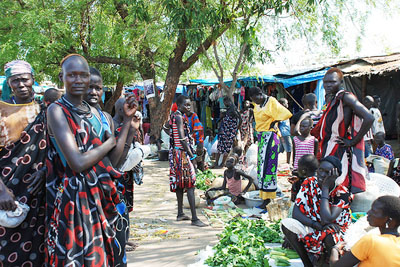
While international media and diplomats are focused on last-minute preparations for Sudan’s elections and the latest controversy stemming from remarks by the big movers and shakers of Sudanese politics, the issue of violence in the South is seemingly slipping below the radar – despite the direct impact southern insecurity will have on next month’s polls.
Lise Grande, the U.N.’s top humanitarian official in the South, paints an alarming picture of the current security trends. Based on information available to date this year, the South is already well on its way to surpassing the number of inter-tribal clashes that took place during all of 2009. Grande told VOA:
What we saw last year was a very sharp rise in inter-tribal violence…There were about 100 separate tribal conflicts last year, and as a result of that, there were almost 400,000 people which were newly displaced. This year alone, since the first of January, we have had more than 70 incidents, just in the first two-and-a-half months of this year.
Grande estimates that already 450 people have been killed and nearly 60,000 displaced by this year’s violence.
But inter-communal fighting is only the tip of the iceberg when surveying the South’s complex security landscape. One disturbing trend in this year’s intra-South violence is the number of incidents between soldiers in the southern Sudanese army, or SPLA, and civilians, particularly in areas where the army is conducting civilian disarmament campaigns. From remote areas of Unity and Lakes state to Terekaka County (just 100 kilometers from Juba), reports of gunfights between angry civilians and SPLA are emerging frequently.
The latest grim news came from Terekaka, where The Citizen (a Sudanese newspaper) reported that 2,000 SPLA soldiers have been deployed to contain the unrest following a disarmament attempt that went awry. The Citizen reported that civilians have been raped and killed, and their homes and shops looted, during military-led efforts to calm the situation following the attempted disarmament in December. The situation in Terekaka is emblematic of the problems associated with disarmament across the South, where marginalized (and well-armed) tribal-based communities – such as the Mundari in Terekaka – fear giving up their weapons due to persistent threats from neighboring groups. While the purported aim of army-led disarmament is to promote security in advance of the elections, this year’s efforts have largely had the opposite effect, especially in areas that are already experiencing localized violence over resources such as land and water for cattle.
Tensions have also spiked between the SPLA and the Misseriya, a pastoral Arab group whose migration patterns straddle the North-South border. Disagreements over whether the Misseriya can bring arms when they come to the South to graze have led to reported clashes between Misseriya herders and SPLA soldiers along the Southern Kordofan-Unity state border. Despite a recent agreement reached at a “border conference” held in Unity state, which resolved to permit the Misseriya to bring a limited number of arms when they cross the border and promised them the extra protection of local authorities, it is clear that hostilities remain. Last weekend, 13 more were killed in clashes between the army and the Misseriya.
The continued displacement and killing of South Sudanese civilians have largely been overshadowed by diplomatic talk and elections that are unlikely to effect significant change for people on the ground. Much of the problem lies in the assumption, implicit in the Comprehensive Peace Agreement, that the only issue to address in Sudan is the dynamic between North-South; South-South dynamics remain unresolved.

